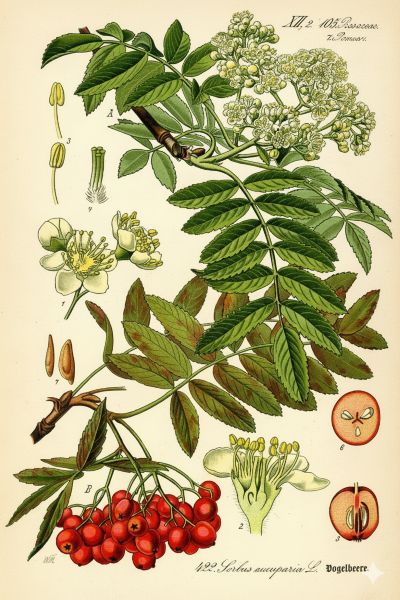Common Rowan (Mountain Ash)
Common Rowan
Sorbus aucuparia L.
Family Rosaceae
Description of Rowan
Common Rowan is a deciduous tree or shrub, 4–15 m tall, with grey bark and a spreading crown. The leaves are odd-pinnate, 10–20 cm long, with 9–15 serrated leaflets (3–5 cm). The flowers are white, 5–10 mm, gathered in corymbose inflorescences (10–15 cm). The fruits are round berries, 8–10 mm, red or orange-red, with a bitter-sour taste. Varieties: 'Titan', 'Rubinovaya' (Ruby), 'Nezhinskaya', 'Konzentra', 'Edulis' (Moravian Sweet). Flowering occurs in May–June, fruiting in August–September.
Habitat and Ecology of Rowan
The homeland of rowan is Europe, West Asia, and the Caucasus. It grows in forests, on forest edges, and in mountains, up to 2000 m above sea level. It is cultivated in Russia, Ukraine, and the Baltic countries. It prefers loamy or sandy soils (pH 5.5–7.0), partial shade or sun, and requires watering with 15–20 l/tree every 10–14 days. It reproduces by seeds, cuttings, and grafting. Yield: 10–30 kg/tree. Care includes pruning, fertilizing with phosphorus (15–20 g/m²), and protection from aphids and rowan moths. It is used in landscaping, for hedges, and as a honey plant.
Rowan Raw Material
Raw materials: fruits (fructus Sorbi aucupariae), leaves (folia Sorbi aucupariae), bark (cortex Sorbi aucupariae). Fruits are harvested in August–September after the first frosts, dried at 40–50 °C (yield 20–25%). Leaves are harvested in June–July, dried at 40 °C (yield 15–20%). Bark is harvested in spring, dried at 30–40 °C (yield 10–15%). Quality: fruits — red, mold-free; leaves — green; bark — brown; moisture ≤12%. Store in airtight containers (fruits: 1 year; leaves: 1 year; bark: 2 years). The smell is faint, the taste is bitter-sour (fruits), neutral (leaves, bark).
Chemical Composition of Rowan
Fruits: water (80%), sugars (up to 8%), organic acids (malic, citric, up to 2%), pectins (up to 1%), vitamin C (up to 70 mg%), A, E, flavonoids, anthocyanins, minerals (K, Fe, Mg). Leaves: flavonoids, tannins (up to 4%), vitamin C (up to 50 mg%). Bark: tannins (up to 6%), flavonoids. Caloric content of fruits: 50–60 kcal/100 g (fresh), 250–300 kcal/100 g (dried).
Action and Application of Rowan
Rowan has astringent, diuretic, anti-inflammatory, antioxidant, and general tonic effects. It is used for avitaminosis, anemia, hypertension, colds, diarrhea, and kidney diseases. Fruits strengthen immunity, improve blood circulation, and normalize digestion. Leaves help with throat inflammation and skin irritations. Bark is used for fever and wound healing. Fruit juice increases appetite and lowers fever.
Precautions for Rowan Use
Consumption of >300 g/day of fresh or >100 g/day of dried fruits can cause diarrhea and stomach irritation. Store juice at 0–5 °C for no longer than 24 hours. For children under 3 years, give ≤30 g/day of fruits. Unripe berries contain parasorbic acid (may cause nausea). Long-term use of bark infusions (>2 weeks) requires medical supervision. Wash fruits thoroughly due to pesticides.
Contraindications for Rowan Use
Allergy to Rosaceae, gastritis with high acidity, acute stomach ulcer, urolithiasis, pregnancy, lactation.
Rowan Recipes
- Fruit Infusion for Avitaminosis. Pour 200 ml of boiling water over 20 g of dried fruits, infuse for 30 minutes, drink 50 ml twice a day for 10 days.
- Bark Decoction for Fever. Boil 5 g of bark in 200 ml of water for 10 minutes, drink 50 ml twice a day for 5 days.
- Lotions for Dermatitis. Pour 100 ml of boiling water over 10 g of leaves, infuse for 20 minutes, apply for 15 minutes, twice a day for 7 days.
- Juice for Anemia. Drink 50 ml of fruit juice twice a day for 7 days.
- Rowan Berry Tea. Steep 1 tablespoon of dried rowan berries in 250ml hot water for 10 minutes. Drink for immune support.
Rowan Cosmetics
Rowan is used for skin care.
- Rejuvenating Mask. 20 g of fruit pulp, 10 ml of honey, apply for 15 minutes, rinse, twice a week.
- Lotion for Oily Skin. 20 ml of fruit juice, 10 ml of water, wipe skin, once a day.
- Moisturizing Mask. 20 g of pulp, 10 ml of yogurt, apply for 20 minutes, rinse, twice a week.
- Leaf Infusion for Acne. Pour 100 ml of boiling water over 10 g of leaves, infuse for 20 minutes, wipe skin, twice a day.
- Rowan Berry Facial Toner. Dilute fresh rowan berry juice with witch hazel and use as a toner for clear skin.
Rowan Culinary Uses
Fruits are used fresh, dried, in beverages, and desserts.
- Compote. 200 g of fresh fruits, 1 liter of water, 50 g of sugar, boil for 15 minutes.
- Jam. 1 kg of fruits, 800 g of sugar, 200 ml of water, boil for 30 minutes, store in jars.
- Tincture. 200 g of fruits, 500 ml of vodka, 50 g of sugar, infuse for 3 weeks, strain.
- Smoothie. 100 g of fruits, 100 ml of yogurt, 10 g of honey, blend.
- Rowan Jelly. Cook rowan berries with sugar and a little water, then strain and boil the liquid until it sets into a vibrant jelly, perfect with game meats or toast.
- Rowan Berry Wine. Ferment rowan berries with sugar and yeast to create a distinctively flavored homemade wine.
- Baked Apples with Rowan. Core apples and fill them with a mixture of rowan berries, honey, and cinnamon, then bake until soft.
- Rowan Berry Sauce for Meats. Create a tart sauce by simmering rowan berries with a touch of sugar, vinegar, and spices, ideal for poultry or venison.
Tips: Store fresh fruits at 0–5 °C for up to 1 month, dried for up to 1 year. Harvest after the first frosts to reduce bitterness.
Other Properties of Rowan
Used in ornamental landscaping, for hedges, and as a honey plant.




